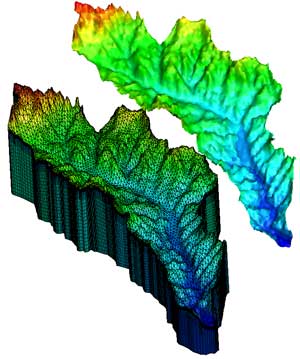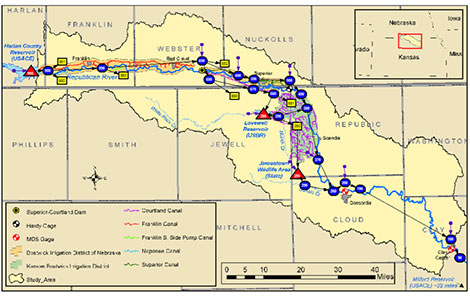Impacts of climate change on water resources
Current work includes research into the impacts of climate change on a variety of hydrologic systems using field observations and numerical tools, ranging from fully-integrated surface/subsurface flow and transport models, to analytical solutions and statistical methods. One of the goals of this research is to better understand the role of groundwater-surface water interactions in the response of the hydrologic system to changing precipitation quantities and patterns, and other changing atmospheric conditions. Research is being conducted in a variety of environmental conditions, including karst systems, alluvial aquifers, and deep, heavily-utilized aquifers.
Water resources management
Few river systems remain unaltered by engineered water management structures. Yet research investigating the interdependence between natural and engineered components of the hydrologic system within a modeling framework is limited. Most current models either focus on the natural system, incorporating only a portion of the engineered structures and often excluding elements like reservoir operations, or focus on the engineered system, simplifying the temporal and spatial variations of the surface water/groundwater flow system.

Previous work linked an object-oriented model of surface water operations into a physically-based, fully-integrated surface/subsurface hydrologic model to capture the effects of water management decisions on the groundwater and surface water flow systems for the Lower Republican River Basin in Kansas. Current work is simulating a variety of adaptive operational methods for ensuring water availability to stakeholders in the basin into the future, under a variety of climate conditions.

Integrating satellite-based data with in-situ measurements to evaluate water availability
GRACE-derived observations of terrestrial water storage (TWS) provide many new opportunities for water resources research, yet their relation to ground truth can be confusing. This work uses clear comparisons to better understand GRACE-derived observations. In this study, GRACE-based observations are compared to in-situ data for the High Plains Aquifer (HPA) in Kansas, USA, where an unusually good in-situ data set exists. Preliminary results indicate that GRACE observations should not be considered a reflection of the trends in water storage in the HPA in KS. Beyond the HPA, this research indicates that the trends in TWS estimated from GRACE observations in regions with deep groundwater aquifers may not reflect trends in water availability in the aquifer due to thick vadose zones and subsequent long recharge times.
Surface/Subsurface thermal energy transport model development
Further development and refining of the fully-integrated surface/subsurface thermal energy transport component of HydroGeoSphere is ongoing to better represent atmospheric inputs to the surface and subsurface.
